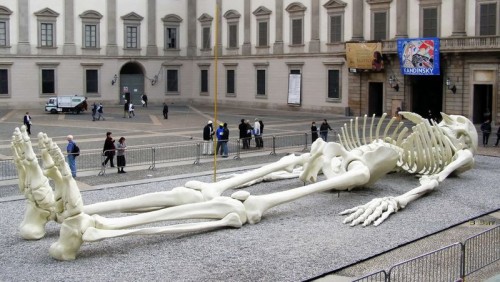Concept Flash
The Concept Flash is not about an emotion (that would be expressionism, aka Kafka), but rather something larger, an idea.
The idea is then set, into concrete.
The logic of the idea follows the dialectic of the concept. This can assist you, in a structural sense, or even with the setting, characterization, narrative, etc. The attributes of the concept can be appropriated for technique within the flash. The concept flash is infinite in its manner. You could write a lifetime of these: ideas in our lives represented as things. Stop digging holes with your fingers. I am offering a type of shovel. OK, a spoon.
Will you shut up and provide an example?
Yes, I will provide an example.
Cube by Amelia Gray.
Picnic. Pringles and such. Enter enormous cube:
It was a massive monolith, wider than it was tall and taller than anyone could reach, wavering like an oasis in the heat.
It has an inscription: EVERYTHING MUST EVENTUALLY SINK.
I see this as conceptualization. In a different manner, Thomas Hardy addresses the idea in “During Wind and Rain.” The same force moves the stones in Frost’s wall.
Something there is that doesn’t love a wall
Damn skippy. It’s physics or whatnot. It’s entropy, or the tendency for all to degrade. Or, as Yeats put it:
Things fall apart; the centre cannot hold.”
Everything tending toward disorder. Or go clean your room right now and go check it out Friday, etc. It will be less clean, not more. Unless you added energy, in the form of work. No worries, though, as soon as you stop working, your room will continue to fall apart. Dust drifting down. Buy a car and I’ll see you in five years. The car won’t look as new. Where did your good go? Have you seen Charlie Sheen lately? Etc.
But, to my point, does the cube follow the logic of the concept, entropy? It do.
1. It burns to the touch. So does the idea of falling apart. You and me, dust to dust. Simone-Ernestine-Lucie-Marie Bertrand de Beauvoir, in The Prime of Life (warning! badass book alert!), writes about how as a teenager it suddenly dawned on her—I am going to die. To be obliterated. The young Simone threw her body on the ground and rolled about her room, caught in an existential teenager persnickety fit. She felt the hot touch of entropy. Later she collected herself and slept with Sartre.
2. The cube is tremendous and unwieldy. Entropy is tremendous. It is a cousin of Time, half-sister of the pale horse, Mr. Reaper, Grim. It hunts and herds, or stares us down, silently. It is a big thing.
3. The humans try to rationalize their way around the cube. To talk or think it away. There must be something that doesn’t sink.
The words caused an uncomfortable stir among the gathered crowd.
“What about Noah’s Ark?” asked one man in the silence.
“After the flood, the ark was lost in the sand.”
“What about buoys?”
“Given time and water retention,” said a woman who worked in a laboratory, “a buoy will sink like the rest.”
This was disconcerting news. Everyone stood around a while, thinking.
“What about an indestructible balloon?”
“Such a contraption does not exist, and is therefore not a thing.”
“A floating bird, such as a swan?”
“It will die and then sink,” the first man said, annoyed.
One man made to rest against the iron cube and stepped back, grimacing in pain at the surface heat.
“A glass bubble, then.”
The laboratory woman shook her head. “The glass would eventually erode, as would polymer, plastic, wood, and ceramic. We are talking thousands of years, but of course it would happen.”
The group was becoming visibly nervous.
“The mind blanks at the glare,” Philip Larkin writes.
In devastating lines of a devastating poem, he continues:
And so it stays just on the edge of vision,
A small unfocused blur, a standing chill
That slows each impulse down to indecision
Most things may never happen: this one will
This one will.
Gray echoes Larkin with, It didn’t budge.
This cube, talk all you want. It’s not going to fucking budge.
14. And what an ending to our ending. Following the logic of the consideration right along. Again, note that the actual story is aware of the syllogistics of the concept. The ways we react are driving the plot to its conclusion.
The mothers didn’t talk much, preoccupied with children or ducks. As they sat, some thought about the children, and some thought about everything eventually sinking, but most thought of the long drive ahead, the end of the weekend, and the days after that.
Things do fall apart. We fall apart. We are falling apart. We will fall apart. But yet we get up from bed, feed ducks, and fall forward.
Indeed.
And now you have it, the Concept Flash. Go write one.
Tags: amelia gray, conceptual rabbits, Eat rotel dip, flash fiction


vipstores.net
vipstores.net
[…] Sean Lovelace breaks CUBE down at HTMLGIANT. […]
To set ‘against’ entropic dispersal and leveling: the structure of relations of mass (‘gravitational field’) might be or indicate the existence of a vortex (or vortical potential) inbuilt in matter/energy that concentrates, that makes possible increased complexity of organization. – a Maxwell’s demon intrinsic to matter/energy: a self-selecter.
loveshopping.us